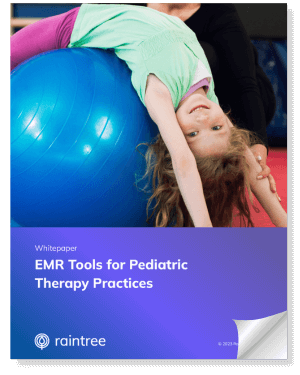The use of telehealth in pediatric physical therapy, occupational therapy, and speech therapy has significantly increased in the past several years.
For one thing, the pandemic saw a major leap in demand for telehealth software for pediatric therapy. But even after the “return to normal,” we’ve seen that therapists, parents, and patients of all ages continue to see the benefits of therapy telehealth services.
Telehealth software for pediatric therapy can help create a more engaging and convenient patient experience. But in order to see the greatest ROI from your teletherapy platform, here’s what practices should keep in mind.
Why Is Telehealth Becoming More Popular In Pediatrics?
Telehealth is becoming increasingly popular with parents because it’s much easier to schedule appointments online instead of driving to an office. With telehealth, parents can better fit visits into their family routines and may be able to avoid missing work, disrupting school schedules or canceling activities. In addition, the convenience and accessibility of telehealth can allow patients to save time while accessing specialists further from their homes, which is a great benefit to those managing chronic conditions or living in rural areas.
Is Teletherapy Effective?
Despite common assumptions, many conditions can be effectively addressed without in-office appointments. In fact, the American Medical Association and Wellness Council of America reported nearly 75 percent of emergency health visits could be be diverted via utilization of telemedicine, with about a quarter of those seeking follow up care at a later date. While in-person care may be necessary for some patients, telehealth visits can act as the first step in making an initial assessment and finding the right provider.
Another benefit of teletherapy services is that family members involved in the care of a child can participate more easily and often. During virtual visits, therapists can facilitate interaction between the patient and family members as well as ask questions, share screens and interactive whiteboards, and participate from different locations.
How Does Telehealth Differ For Pediatric Patients?
At times, working with children remotely can be more challenging than working with adults.
Young children may not always be attentive during a visit and often may not be able to answer a therapist’s questions. Furthermore, adolescents or young teens may naturally be reticent and less during therapy sessions. Successful teletherapy depends upon the ability to facilitate an engaging experience, from playful online games and puzzles, to role play and writing exercises.
One significant advantage of telehealth is that visits typically take place with children in their home environment, where they may feel more comfortable. Going to the doctor can cause stress for young patients, since they may feel concerned about seeing unfamiliar people or getting a shot. At home, however, children are often far more relaxed. With virtual visits, occupational therapists, speech therapists, or PTs can better gauge the patient’s developmental milestones by seeing them in a non-clinical environment and gaining a better sense of their everyday routines.
How to Introduce Telehealth In Your Pediatric Practice
If you haven’t offered telehealth before, you should know that it’s an adjustment. For patients and providers!
When implementing telehealth software at a pediatric practice for the first time, it’s essential to consider factors such as:
- User-friendliness. Does the platform use interfaces that are easy for both parents and young patients to navigate?
- Compliance. Does the software meet regulatory standards (HIPAA applies to virtual visits too!)
- Efficiency. Does the software integrate with your electronic health records (EHR) or electronic medical record (EMR) system? What about your practice management software?
- Financial factors. Is there a demand for virtual services among your current patients? Or would offering teletherapy help you reach new ones?
While implementing these changes, you’ll want to make sure to train staff to effectively use the new platform, as well as any changes to documentation requirements, scheduling and billing processes, and other clinical workflows.
Creating the Right Environment for a Virtual Visit
On the clinician’s side of the camera, there are a few things you’ll need at your workstation. First, you need a smart device–such as a computer, laptop, or tablet that has both audio and video, along with a high-speed Internet connection. You’ll want to close other programs that are running. Also, you should be in a space with adequate lighting to ensure that patients can see you clearly. And of course, to maintain patient privacy and HIPAA compliance, you’ll need to ensure that this space is private and secure.
For patients, creating the right environment is equally important. Before the appointment, you can send out some simple tips for parents, which might involve setting up a quiet, distraction-free space for their child to use during the session. Even though the home environment may be more comfortable, it’s also harder to control. Siblings, pets, and other stimulus in the environment could interrupt the patient’s attention. Additionally, you might want to set up a virtual waiting room, where parents and their children can sign in and prepare for the session before it starts.
HIPAA Compliant Telehealth Software for Pediatric Therapy
Offering telehealth doesn’t mean you can use any old video conferencing software. You need HIPAA-compliant telehealth software that allows you to connect to your patients securely and privately.
When seeking telehealth technology, look for an all-in-one platform that offers more than just virtual visits. Top-tier solutions provide digital communication tools that let you consistently build relationships by keeping in touch throughout the entire patient journey by way of blast email campaigns, text notifications and even automated surveys or clinical questionnaires. Also, these solutions can be integrated with your payment and billing software, helping your practice secure revenue faster and create a better client experience, too.
All-in-One EHR and Practice Management Software for Pediatric Therapy
Telehealth allows you to serve more patients and keep up with the demand for virtual care. When performed correctly, it can also help improve the quality of treatment and provide convenient access to those who may not be able to attend in-person visits so easily. However, given the need for security and privacy, the right software is essential for every pediatric practice that wants to offer telehealth.
Here at Raintree Systems, we help physical therapy, occupational therapy, speech-language pathology and multi-disciplinary practices grow and succeed with scalable and robust software solutions. Raintree offers the first ONC-certified EHR system designed specifically for rehab therapy. Want to learn more? Schedule a demo and learn why high-growth PT, OT, SLP, and multi-disciplinary practices choose Raintree.



